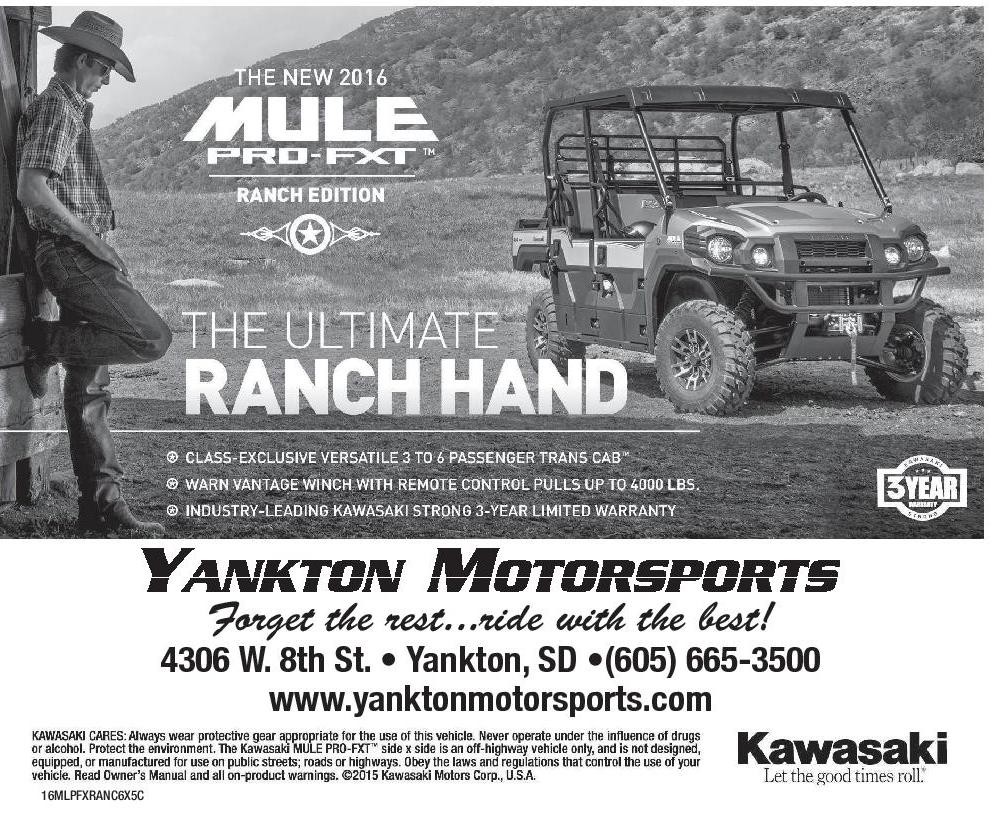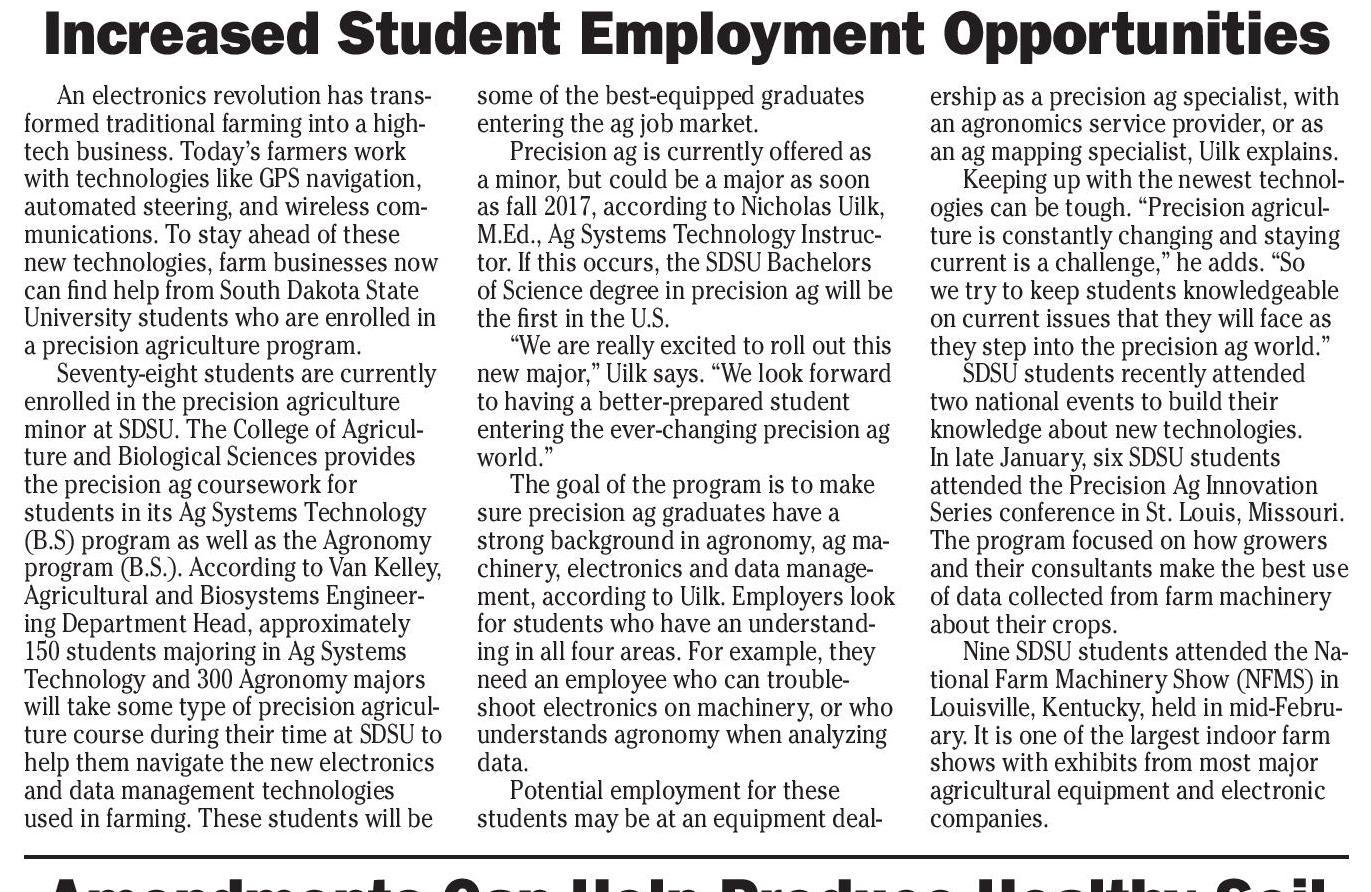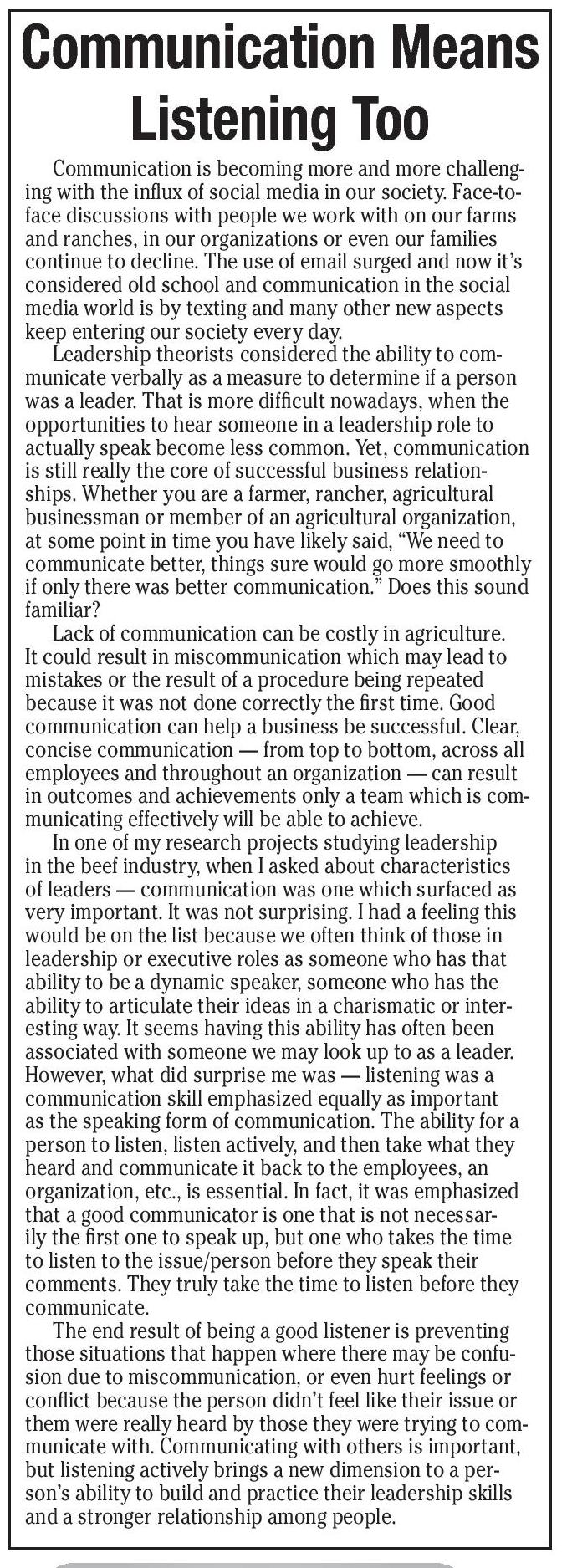17








shop online at www.missourivalleyshopper.com
March 15, 2016 • Page 17
National Ag Week
March 13-19, 2016
Increased Student Employment Opportunities Communication Means
An electronics revolution has transformed traditional farming into a hightech business. Today’s farmers work
with technologies like GPS navigation,
automated steering, and wireless communications. To stay ahead of these
new technologies, farm businesses now
can find help from South Dakota State
University students who are enrolled in
a precision agriculture program.
Seventy-eight students are currently
enrolled in the precision agriculture
minor at SDSU. The College of Agriculture and Biological Sciences provides
the precision ag coursework for
students in its Ag Systems Technology
(B.S) program as well as the Agronomy
program (B.S.). According to Van Kelley,
Agricultural and Biosystems Engineering Department Head, approximately
150 students majoring in Ag Systems
Technology and 300 Agronomy majors
will take some type of precision agriculture course during their time at SDSU to
help them navigate the new electronics
and data management technologies
used in farming. These students will be
some of the best-equipped graduates
entering the ag job market.
Precision ag is currently offered as
a minor, but could be a major as soon
as fall 2017, according to Nicholas Uilk,
M.Ed., Ag Systems Technology Instructor. If this occurs, the SDSU Bachelors
of Science degree in precision ag will be
the first in the U.S.
“We are really excited to roll out this
new major,” Uilk says. “We look forward
to having a better-prepared student
entering the ever-changing precision ag
world.”
The goal of the program is to make
sure precision ag graduates have a
strong background in agronomy, ag machinery, electronics and data management, according to Uilk. Employers look
for students who have an understanding in all four areas. For example, they
need an employee who can troubleshoot electronics on machinery, or who
understands agronomy when analyzing
data.
Potential employment for these
students may be at an equipment deal-
ership as a precision ag specialist, with
an agronomics service provider, or as
an ag mapping specialist, Uilk explains.
Keeping up with the newest technologies can be tough. “Precision agriculture is constantly changing and staying
current is a challenge,” he adds. “So
we try to keep students knowledgeable
on current issues that they will face as
they step into the precision ag world.”
SDSU students recently attended
two national events to build their
knowledge about new technologies.
In late January, six SDSU students
attended the Precision Ag Innovation
Series conference in St. Louis, Missouri.
The program focused on how growers
and their consultants make the best use
of data collected from farm machinery
about their crops.
Nine SDSU students attended the National Farm Machinery Show (NFMS) in
Louisville, Kentucky, held in mid-February. It is one of the largest indoor farm
shows with exhibits from most major
agricultural equipment and electronic
companies.
Amendments Can Help Produce Healthy Soil
Mother Nature provides
plenty to grow healthy
lawns, gardens and landscapes. But as many homeowners know, some lawns
sometimes need a little
extra boost to complement
nature. Soil sometimes must
be amended so plants can
thrive. Only after the right
composition is created can
plants take root and perform
to the best of their abilities.
The Colorado State
University Extension defines
a soil amendment as any
material added to soil to
improve its physical properties. The goal is to provide a
better environment for roots.
Depending on what you are
starting with, any number of
ingredients must be added
to the soil recipe. Water retention, permeability, drainage, aeration, nutrients, and
water infiltration are some of
the things amendments can
improve when added to soil.
Before homeowners add
anything to the soil in their
yards, it is first important
to determine what that soil
needs. Homeowners may
notice if soil is overly sandy
or full of clay, but further
testing can confirm what
the soil is lacking. Soil tests
are often available through
local cooperative extension
offices or private laboratories. Speak with a nursery or
garden center about where
you can get your soil tested.
A comprehensive test may
cost between $5 and $10
and can provide invaluable information that saves
you hundreds of dollars in
wasted plants and materials,
not to mention effort. Some
labs also can tailor their
recommendations based
on the type of planting you
will be doing. For example, a
vegetable garden may need
different amendments than a
row of azalea bushes.
Organic matter is a
preferred soil amendment
used by professional and
novice gardeners alike. The
decaying remains of plants
release nutrients that are
absorbed into the soil and
used by microorganisms and
bacteria, creating a healthy
environment for plants. Organic material may break up
compacted soil to increase
drainage. In sandy soil,
organic material serves as a
sponge to keep water from
washing away. Compost and
manure are two examples
of frequently used organic
materials. Both of these materials are readily available
at little cost.
Compost can be produced at home from food
and plant scraps. Raked
leaves and small amounts of
grass clippings can be added
to compost. Over time, the
decomposition process will
turn scraps into a nutrientrich, dark brown substance
that provides many plants
with all they need to thrive.
Compost is particularly useful in vegetable gardens.
Manure should come
from herbivores, or those
animals that sustain
themselves on grass and
other plants. Carnivores can
produce harmful bacteria in
their waste, which is not safe
to use in gardens, particularly food-bearing gardens.
Manure can be commercially
purchased, or avid gardeners can work out arrangements with nearby livestock
owners and farms. These
people may be more than
willing to give you manure
for little to no cost if you
cart it away. Dried manure
is preferred because it will
have minimal odor.
Additional forms of
organic amendments include
wood ash, sphagnum peat,
wood chips, sawdust, and
worm droppings.
Inorganic amendments
also may be used, and
are usually relied on to
improve water retention
and drainage. Vermiculite,
perlite, pea gravel, and sand
are examples of inorganic
amendments. A combination of organic and inorganic
amendments can create the
perfect mix for your needs.
Soil amendments typically are added to new and
unplanted beds. Peat moss
and shredded bark take
years to decompose and will
serve as long-term amendments in the soil. Compost
breaks down quickly and
may need to be worked in
more frequently.
Experts recommend
spreading amendments on
the planting bed and then
using a rake or tiller to work
it in to a depth of about nine
inches. Particularly sandy
soil or soil with a lot of clay
may need more amendments.
Permanent plants, such
as trees or shrubs, also
can benefit from the extra
nutrient boost amendments
provide. Sometimes it is sufficient to spread the material
over the soil surface and let
rainwater and wildlife help
distribute it to the plant
roots. Otherwise, work it
into the top inch or two of
the dirt with a hand cultivator.
Soil amendments can be
the difference between a
thriving garden and healthy
landscape and one that has
seen better days.
HVAC & Electrical Contractors
Power Source
Electric
Your Heating & Cooling
Specialists
665.2895
Residential & Commercial
Electrical Contractors
260.8683
Divisions of Electair, Inc.
Chris Frick
Doug Dykstra
DEALER
KEVIN HAHN MANAGER
1504 East Hwy 50, Yankton, SD 57078
phone. 605.260.1522 or 866.760.3279
sttr@iw.net / fax. 605.260.1523
stockmenstrailersales.net
• Full Turn-Key Pivots
• Electrical Controls
• Inject-O-Meters
Listening Too
Communication is becoming more and more challenging with the influx of social media in our society. Face-toface discussions with people we work with on our farms
and ranches, in our organizations or even our families
continue to decline. The use of email surged and now it’s
considered old school and communication in the social
media world is by texting and many other new aspects
keep entering our society every day.
Leadership theorists considered the ability to communicate verbally as a measure to determine if a person
was a leader. That is more difficult nowadays, when the
opportunities to hear someone in a leadership role to
actually speak become less common. Yet, communication
is still really the core of successful business relationships. Whether you are a farmer, rancher, agricultural
businessman or member of an agricultural organization,
at some point in time you have likely said, “We need to
communicate better, things sure would go more smoothly
if only there was better communication.” Does this sound
familiar?
Lack of communication can be costly in agriculture.
It could result in miscommunication which may lead to
mistakes or the result of a procedure being repeated
because it was not done correctly the first time. Good
communication can help a business be successful. Clear,
concise communication — from top to bottom, across all
employees and throughout an organization — can result
in outcomes and achievements only a team which is communicating effectively will be able to achieve.
In one of my research projects studying leadership
in the beef industry, when I asked about characteristics
of leaders — communication was one which surfaced as
very important. It was not surprising. I had a feeling this
would be on the list because we often think of those in
leadership or executive roles as someone who has that
ability to be a dynamic speaker, someone who has the
ability to articulate their ideas in a charismatic or interesting way. It seems having this ability has often been
associated with someone we may look up to as a leader.
However, what did surprise me was — listening was a
communication skill emphasized equally as important
as the speaking form of communication. The ability for a
person to listen, listen actively, and then take what they
heard and communicate it back to the employees, an
organization, etc., is essential. In fact, it was emphasized
that a good communicator is one that is not necessarily the first one to speak up, but one who takes the time
to listen to the issue/person before they speak their
comments. They truly take the time to listen before they
communicate.
The end result of being a good listener is preventing
those situations that happen where there may be confusion due to miscommunication, or even hurt feelings or
conflict because the person didn’t feel like their issue or
them were really heard by those they were trying to communicate with. Communicating with others is important,
but listening actively brings a new dimension to a person’s ability to build and practice their leadership skills
and a stronger relationship among people.
COMPLETE TRUCK REPAIR
•FARM TRUCKS – ALL SIZES
•SEMI TRUCKS & TRAILERS
Friendly, Honest
Repair
TOP QUALITY
SERIVCE
Varilek
Over 60 Years
Experience
Truck repair, iNc.
E3507 East Hwy. 50, Yankton, SD • 1-605-665-1447
• Piping
• Well Panels
• Wiring
We are a full-service dealer with
extensive parts supply, and we
service all electric brands.
Forget the rest...ride with the best!
4306 W. 8th St. • Yankton, SD •(605) 665-3500
www.yanktonmotorsports.com
16MLPFXRANC6X5C
16MLPFXRANC6X5C
Now locally owned!
301 South St. • Hartington, NE
402-254-9557
“Your full-service Zimmatic Dealer!”

































 Previous Page
Previous Page





